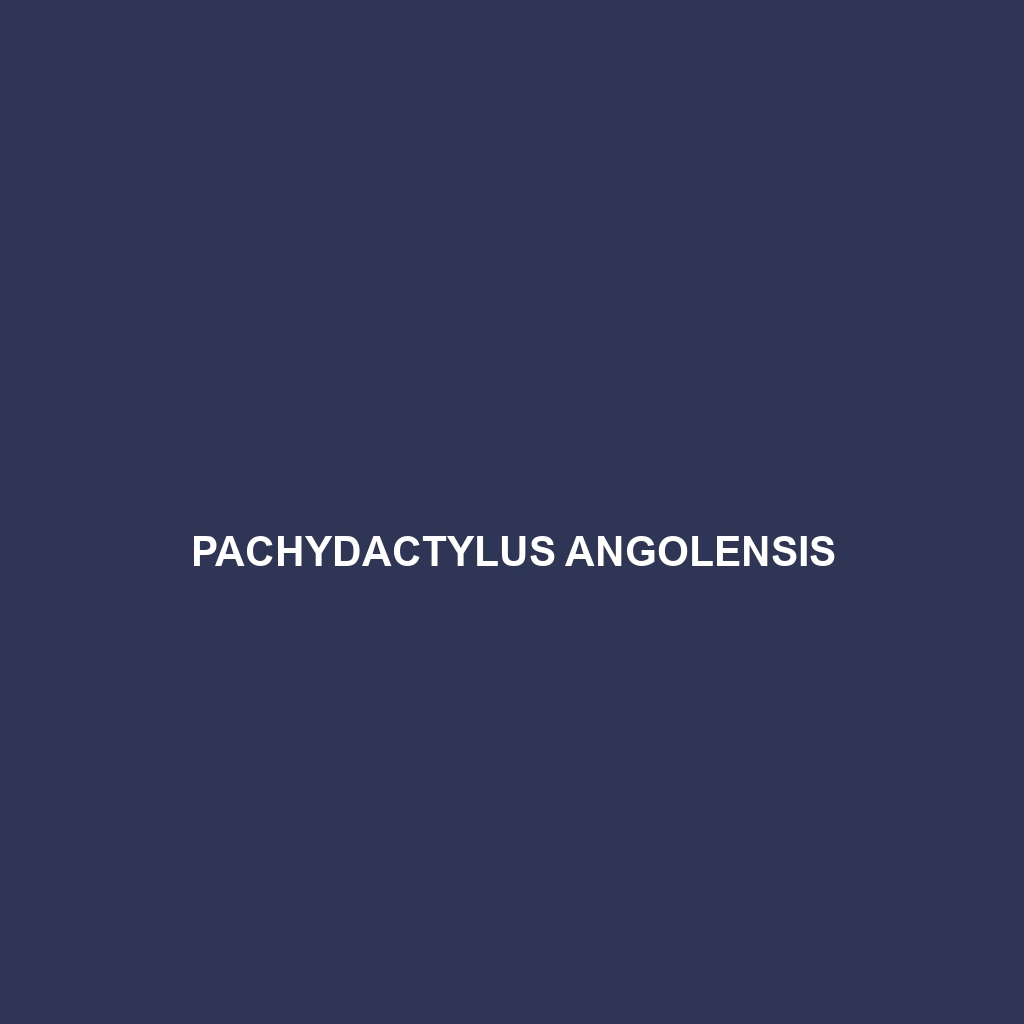Common Name
Pachydactylus angolensis
Scientific Name
Pachydactylus angolensis
Habitat
Pachydactylus angolensis, commonly known as the Angola thick-toed gecko, primarily inhabits the diverse environments of Africa, particularly within the southern regions of Angola and surrounding areas. This species thrives in a variety of habitats, including savannas, grasslands, and coastal regions. Characterized by a warm climate, these areas often experience both dry and wet seasons, providing a unique ecosystem that supports various flora and fauna. The Angola thick-toed gecko exhibits a preference for environments where there is sufficient ground cover, like grasses and shrubs, which offer shelter and hunting grounds. Additionally, its adaptability allows it to survive in slightly arid conditions, making it a resilient species in fluctuating climates.
Physical Characteristics
The Pachydactylus angolensis is distinguished by its unique physical features. Adults typically reach a length of approximately 10 to 15 centimeters (4 to 6 inches). Its most notable characteristic is its thick, flattened toes, which are particularly effective for climbing and gripping surfaces. The coloration of this gecko ranges from sandy beige to earthy brown, often with darker stripes or spots that provide effective camouflage against the ground. This cryptic coloration not only aids in evasion from predators but also blends with its habitat, enhancing its survival rate. Its large, prominent eyes are adapted for low-light visibility, supporting its predominantly nocturnal lifestyle.
Behavior
The behavior of Pachydactylus angolensis is quite fascinating, particularly its nocturnal habits. Being primarily active during the night, this gecko has developed hunting and social behaviors that are specific to low-light conditions. During the day, it often seeks refuge in crevices or beneath stones to avoid the heat. Socially, these geckos exhibit territorial behaviors, particularly males, who may engage in displays to ward off competitors. Mating rituals are also intriguing; during the breeding season, males often perform elaborate courtship displays, which may include head bobbing and push-ups to attract females. The use of vocalizations, though not extensively documented, is believed to play a role in their social interactions.
Diet
Pachydactylus angolensis is classified as an insectivore, predominantly feeding on invertebrates such as spiders, crickets, and various insect larvae. The gecko’s diet mainly consists of small arthropods that it catches using its keen eyesight and agile movements. They are opportunistic feeders, meaning they will consume whatever prey is available in their environment. Catching prey often involves a combination of stealth and quick strikes, showcasing their adaptability in hunting strategies. This diet not only sustains their energy levels but also supports their ecological role by helping control insect populations.
Reproduction
The reproductive cycle of Pachydactylus angolensis involves complex behaviors that reflect its adaptability to the environment. Breeding generally occurs during the warmer months when food availability is optimal, which usually coincides with the rainy season. Females lay clutches of 1 to 2 eggs, which they bury in loose soil or sand, providing a nurturing environment for the embryos. The gestation period is typically between 30 to 60 days, depending on environmental conditions. After hatching, the young geckos are independent and exhibit behaviors similar to adults almost immediately, including self-sufficient feeding and shelter-seeking behaviors.
Conservation Status
The current conservation status of Pachydactylus angolensis is listed as Least Concern according to the International Union for Conservation of Nature (IUCN). However, it faces challenges such as habitat loss due to agricultural expansion and urbanization. Conservation initiatives aimed at habitat preservation are vital in ensuring the continued survival of this species. By promoting the importance of its natural habitats, conservationists work to maintain the ecological balance within these regions. Engaging local communities in conservation efforts is essential to reduce human impact and promote biodiversity.
Interesting Facts
One intriguing aspect of Pachydactylus angolensis is its ability to adapt to various environmental conditions. This gecko can alter its body behavior and coloration to optimize its camouflage depending on surroundings, which is not commonly observed in all reptile species. Furthermore, these geckos have a remarkable defensive mechanism; when threatened, they may drop their tails, which can continue to wiggle, distracting predators and giving the gecko a chance to escape. These adaptations not only enhance their survival but also make them a fascinating subject of study for herpetologists.
Role in Ecosystem
Pachydactylus angolensis plays a critical role in its ecosystem as both a predator and prey. By controlling insect populations, it helps maintain ecological balance, preventing overpopulation of various invertebrates. In turn, it serves as a food source for larger predators, including birds and mammals. Their interactions contribute significantly to food web dynamics, showcasing their importance as a connector in the ecological community. As pollinators, any disturbances to their populations could have ripple effects across their habitat, further emphasizing the need for their conservation.
This detailed species description provides a comprehensive overview of Pachydactylus angolensis while ensuring it is SEO-optimized and formatted for web publication.
